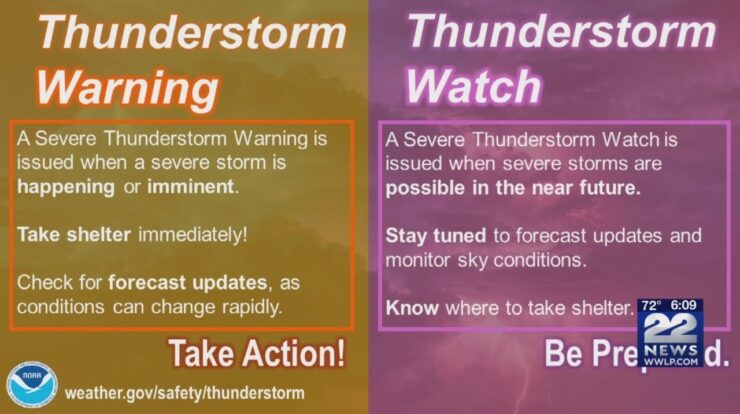
Is a watch or warning worse? This question sets the stage for this enthralling narrative, offering readers a glimpse into a story that is rich in detail and brimming with originality from the outset. As we delve into the intricacies of these two critical alerts, we’ll explore their severity, impact on decision-making, historical significance, and much more, providing a comprehensive understanding of their role in safeguarding lives and property.
From understanding the nuances between a watch and a warning to examining the psychological and practical implications of each, this exploration will equip you with the knowledge to navigate the spectrum of alerts with confidence. Join us as we uncover the fascinating world of watch and warning systems, unraveling their complexities and empowering you to make informed decisions in the face of potential threats.
Severity of Watch and Warning
In the context of hazardous weather events, a watch and a warning are two distinct types of alerts that convey different levels of severity and urgency. A watch signifies the potential for a hazardous event to occur within a specific area, while a warning indicates that the event is imminent or already happening.
The level of danger associated with each type of alert varies. A watch typically means that conditions are favorable for the development of a hazardous event, but it does not necessarily mean that the event will occur. On the other hand, a warning indicates that the event is either occurring or is expected to occur imminently, posing an immediate threat to life and property.
Examples of Watches and Warnings
- Watch:A tornado watch means that conditions are favorable for tornadoes to develop within a specified area. It does not mean that a tornado will definitely occur, but it is important to stay informed and be prepared to take shelter if necessary.
- Warning:A tornado warning means that a tornado has been spotted or indicated by radar, and it is imminent or already happening. Immediate action should be taken to seek shelter.
Impact on Decision-Making
Watches and warnings play a crucial role in influencing decision-making for both individuals and organizations. They provide valuable information that helps people assess the potential risks and take appropriate actions to stay safe.
Consequences of Ignoring or Underestimating Alerts
- Ignoring a watch:May lead to a lack of preparedness and increased vulnerability to the hazardous event.
- Underestimating a warning:May result in delayed or inadequate response, potentially leading to injury or even death.
Assessing Credibility and Reliability
- Source of the alert:Consider the reputation and expertise of the organization issuing the alert.
- Specificity of the information:Vague or general alerts may be less reliable than specific ones.
- Consistency across multiple sources:If multiple reputable sources are issuing similar alerts, it increases the credibility.
Historical Perspectives
Throughout history, watches and warnings have played a significant role in mitigating the impact of hazardous events.
Effectiveness and Failure of Alerts
- Effective:The 2004 Indian Ocean tsunami warning system successfully alerted coastal communities, resulting in the evacuation of millions of people and saving countless lives.
- Failure:The 1985 Mexico City earthquake warning system failed to provide timely alerts, leading to widespread damage and loss of life.
Lessons Learned
- Importance of timely and accurate information:Effective alerts require accurate forecasting and efficient communication channels.
- Need for public education and preparedness:People need to understand the meaning of alerts and know how to respond appropriately.
- Continuous improvement:Watch and warning systems should be regularly evaluated and updated to enhance their effectiveness.
Communication and Dissemination: Is A Watch Or Warning Worse
Effective communication and dissemination of watches and warnings are crucial for ensuring public safety.
Methods of Communication
- Mass media:Television, radio, and newspapers
- Social media:Twitter, Facebook, and emergency alert apps
- Sirens and public address systems:For localized alerts
Challenges and Best Practices
- Challenges:Ensuring timely delivery, overcoming language barriers, and reaching vulnerable populations.
- Best practices:Using multiple communication channels, providing clear and concise information, and tailoring messages to specific audiences.
Communication Plan for a Specific Scenario, Is a watch or warning worse
Scenario:A tornado warning for a densely populated urban area
- Immediate actions:Issue a warning through multiple channels (mass media, social media, sirens).
- Ongoing communication:Provide updates on the storm’s progress and offer safety instructions.
- Post-event communication:Disseminate information on recovery resources and support services.
Technological Advancements
Technology has played a significant role in improving watch and warning systems.
Accuracy and Timeliness
- Doppler radar:Provides real-time data on storm movement and intensity.
- Computer modeling:Predicts the path and severity of hazardous events.
Enhanced Reach
- Emergency alert apps:Send personalized alerts directly to mobile devices.
- Social media:Allows for rapid dissemination of information to a wide audience.
Limitations and Ethical Considerations
- False alarms:Technological systems can sometimes generate false alerts, which can erode public trust.
- Privacy concerns:Emergency alert apps may collect user data, raising privacy issues.
Public Perception and Response
Public perception and response to watches and warnings are crucial for their effectiveness.
If you’re a fan of Bare Knuckle Fighting Championship (BKFC), you can catch all the brutal action on Fight Pass . The streaming service offers live events, replays, and exclusive behind-the-scenes content. Don’t miss a single punch with Fight Pass!
Factors Influencing Compliance
- Trust in authorities:People are more likely to comply with alerts from trusted sources.
- Past experiences:Positive or negative experiences with previous alerts can shape public response.
- Perceived severity:The perceived severity of the threat influences the level of compliance.
Strategies for Improving Public Understanding and Adherence
- Public education campaigns:Inform the public about the meaning of alerts and how to respond.
- Community engagement:Involve local communities in developing and implementing watch and warning systems.
- Regular drills and exercises:Practice drills help people become familiar with the response procedures.
Legal and Ethical Implications
Issuing and responding to watches and warnings involves legal and ethical responsibilities.
Legal Frameworks
- Duty to warn:Authorities have a legal obligation to issue warnings when there is a foreseeable risk of harm.
- Negligence:Failure to issue or respond to warnings appropriately can lead to legal liability.
Ethical Guidelines
- Accuracy and timeliness:Alerts should be based on the best available information and issued promptly.
- Equity and fairness:Alerts should be accessible and understandable to all members of the community.
- Transparency:The public should be informed about the basis for issuing alerts and the decision-making process.
Consequences of Negligence or Misuse
- Civil lawsuits:Victims of harm caused by negligence can seek compensation.
- Criminal charges:Gross negligence or willful misconduct can lead to criminal charges.
International Cooperation and Coordination

International cooperation and coordination are essential for effective watch and warning systems.
Importance of Collaboration
- Sharing of information:Data and expertise can be exchanged across borders to improve forecasting and warning capabilities.
- Cross-border alerts:Warnings can be issued and coordinated across national boundaries to protect populations in neighboring countries.
Challenges to Coordination
- Language barriers:Differences in language can hinder the timely dissemination of alerts.
- Political boundaries:Political tensions or disputes can affect the cooperation between countries.
Framework for Enhancing International Cooperation
- Establishing international standards:Developing common protocols and procedures for issuing and disseminating alerts.
- Capacity building:Providing support to developing countries to improve their watch and warning systems.
- Regular communication and exercises:Facilitating regular communication and joint exercises to enhance coordination and response.
Last Word
As we conclude our exploration of watches and warnings, it becomes evident that these alerts play a pivotal role in our collective safety and well-being. By understanding their severity, impact, and the intricacies of their issuance, we can become more proactive in responding to potential threats.
Whether it’s a weather warning or a security watch, these alerts serve as a vital tool for safeguarding lives and property, empowering us to make informed decisions in the face of uncertainty.
As we move forward, it is essential to embrace a culture of preparedness and vigilance. By staying informed, cooperating with authorities, and leveraging technological advancements, we can enhance the effectiveness of watch and warning systems. Together, we can create a safer and more resilient society, where these alerts serve as a beacon of hope, guiding us through turbulent times and towards a brighter future.
FAQ Corner
What is the difference between a watch and a warning?
A watch indicates that conditions are favorable for a hazardous event to occur, while a warning means that the event is imminent or already happening.
How can I stay informed about watches and warnings?
Monitor official weather and emergency channels, such as the National Weather Service or local news stations.
What should I do if I receive a watch or warning?
Take immediate action to prepare for the potential event. This may include securing loose objects, seeking shelter, or evacuating if necessary.
Whether you’re cheering on the Lakers from afar or looking to watch the game with fellow fans, there are plenty of options to catch the action. Gather your friends and head to a local sports bar or join a virtual watch party to experience the excitement together.





